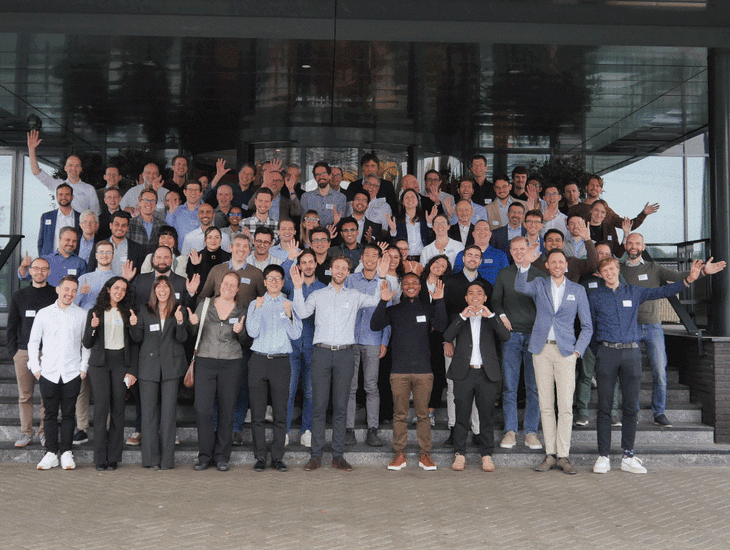#TPRCminds: Wouter Grouve
'We’re in a time of rapid acceleration'
The Thermoplastic Composites Research Center (TPRC) recently celebrated its tenth anniversary. The consortium that started out small with only a handful of researchers has since matured considerably. The key to this success? The people who work at TPRC. Without their expertise and drive, there would be no future.
Read other #TPRCminds interviews with Jeroen (Research Engineer), Yannick (PhD Researcher), Ramona (PhD Researcher), Sebastiaan (AniForm Engineering), Jagadeesh (PhD Researcher), Vanessa (PhD Researcher), and Emiel (Research Engineer).
Wouter Grouve is happy to admit that he’s been positively surprised by the developments in his own field in recent years. “When I first joined TPRC, we firmly believed that one day we would see aircraft being built that largely consisted of thermoplastic composites. However, major players such as Boeing and Airbus had yet to be convinced. Now, it’s a different story. I had expected a slow and steady transition to thermoplastic composites, but the past few years have been a time of rapid acceleration and TPRC has been right at the heart of it all. That’s great to see.”
There from the start
If anyone can rightfully claim to have been at the center of TPRC’s research in recent years, it’s Wouter. In 2012 he obtained his doctorate cum laude at the University of Twente, having discovered a fascination with thermoplastic composites during his PhD research under Professor Remko Akkerman, one of the men behind TPRC. “Remko invited me along to a few of TPRC’s regular Technical Advisory Board meetings back in the day: it was great experience for a young researcher like me. A unique opportunity to talk face-to-face with industry experts about the nature and relevance of my research. There were eight of us at those meetings, you know. Now it’s more like eighty.”
Setting up the lab
On completing his PhD, Wouter spent five years working as a research operations leader at TPRC. In practice, this meant coordinating TPRC’s operational branch. Wouter was the man who decided what equipment to purchase, from the fiber placement machine to ultrasonic welding equipment. “Many of the technical decisions went through me. I helped set up the lab, which meant that my job was very varied and wide in scope. I often saw quick results, which is far from typical for the scientific world.” Wouter also supervised PhD students and co-wrote research proposals, something he still does in his current position at the University of Twente. “My heart lies with those PhD students. Curiosity is in my blood: I want to know how things work. That’s what we have in common. My students are often young, enthusiastic and exceptionally motivated. I definitely learn from them, too. A number of them have gone on to work for TPRC, others for partners such as Toray Advanced Composites (previously TenCate Advanced Composites, ed.).”
Growing reputation
“When I started at TPRC, we had only just moved into our building at Palantijn 15 in Enschede, with a team of around ten people. Since then, things have expanded dramatically. In those early days we had our work cut out for us to build a reputation in the field, but not anymore. How can I tell? Take ITHEC for example, the leading conference on thermoplastic composites held every two years in Bremen, where we now enjoy a place at the forefront. For the upcoming conference in October we submitted two abstracts, both of which were accepted – a rare achievement for a single organisation or company. And of course our status is reflected by the partners we work with: Boeing, Toray Advanced Composites and GKN Fokker to name but a few. They regularly knock on our door for advice and send a good deal of research work our way. Thermoplastic composites is still a relatively small industry in which everybody knows everybody else, but it’s expanding fast.”
How do you see the future?
“As I said, I see a further increase in the growth of thermoplastic composites, although there are some worrying developments. Many companies experienced in metals or thermosetting materials now see the major advantages of thermoplastic composites and are taking an active interest. Sometimes they set out to make the same things they’re making now, and that doesn’t always work. It might be the conservative in me talking, but I believe structural knowledge and rigorous testing are vital, especially in the aviation industry. Apart from those concerns, the current level of interest means the future holds all kinds of interesting and exciting prospects for us. Major companies are daring to take the plunge and invest. I expect to see significantly more thermoplastic composite in the next Boeing model, possibly even in large structural parts like the fuselage or the wings. We will continue to play our part.”
Can you give us an example of how TPRC will play its part in this process?
“Several examples spring to mind. One is our work in the field of induction welding, which is geared towards the efficient assembly of large parts. Another involves a researcher who is laying the foundation for environmentally friendly moulded surfaces in processing thermoplastics. We want to phase out the chemical solvents that are now being used to help release the part from the mold. In other words, looking for new ways to make sure the plastic doesn’t stick to the surface. Our research is taking in innovative materials such as graphene, which works very well as it turns out. I didn’t see that one coming. It can have a huge impact on the industry when you consider how much plastic is processed worldwide. It has already been shown to work in the lab. Now we’re looking at how we can apply it industrially and we’re examining aspects such as wear resistance and how often a layer like that can be used.”
You have returned to the University of Twente and now you’re lecturing into the bargain. How do your students view thermoplastic composites?
“Students, especially in the early stages, are looking for appealing opportunities to apply their work. And materials and composites certainly fit the bill. The subjects I teach include Aircraft Constructions, which is part of the Aircraft Engineering module. This attracts a broad range of students, from Mechanical Engineering and Mathematics to Computer Science and Chemistry. It’s great to work with so many disciplines. This year my students had to come up with a conceptual design for an electric plane capable of flying short distances. They did all the calculations and explored the application of thermoplastic composites. Their enthusiasm and drive is impressive. The future of our profession, and hopefully the future of TPRC, lies with them.”
So you’re hoping to see some of your students make the move to TPRC?
“That would be wonderful. In any case, I hope that we can stay true to our values: putting responsibility in the hands of our employees and giving them plenty of scope for creativity and initiative. To this day, that’s what makes TPRC a great organisation to work for. The bigger you become, the more difficult it is to maintain that kind of balance, but the entrepreneurial spirit at TPRC and the high degree of freedom remain unique and that means we really have something special to offer.”
#TPRCminds
Our series #TPRCminds introduces you to the people behind our success. Who are they? What is
their background? What drives them and what do they dream about? How do they look at the future of thermoplastic composites?
Continue reading other #TPRCminds episodes:
Photos ©Gijs van Ouwerkerk




